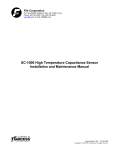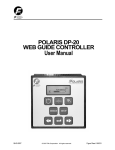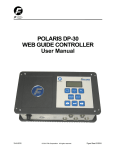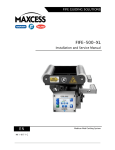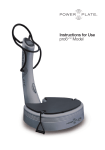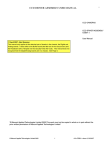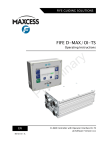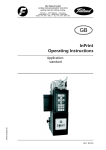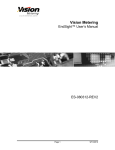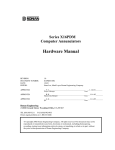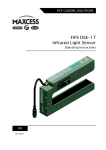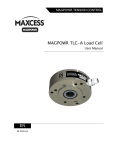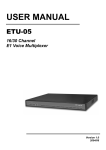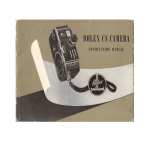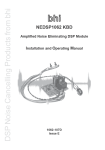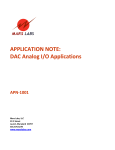Download CDP-01 User Manual
Transcript
CDP-01 Reference Manual 04-23-2013 CDP-01 1-721-C THIS PAGE INTENTIONALY LEFT BLANK 1-721-C CDP-01 04-23-2013 NOTE This Operating Manual will help you to familiarize yourself with the Fife product CDP-01 and to make the fullest and most economical use of its possible applications. Existing national regulations relating to safety and environmental protection should be observed in addition to the Operating Manual. The legally binding safety regulations in the country of use and at the specific location apply. Please also follow the recognized technical rules with regard to safety and proper working practices. The Operating Manual must be kept at hand at all times at the location where the machine is installed. Customer-specific configurations of the CDP-01, together with further technical data, are described in a separate section in the supplementary documentation. They have priority over the information given in this general description. The Operating Manual must be read and applied by all persons entrusted with working on or with the machine, e.g.: operation, maintenance (servicing, inspection, repair) and transportation. Copyright: All rights reserved. Any reproduction of this Operating Manual, in what ever form, in whole or in part, requires the prior written consent of FIFE. The information given in this Operating Manual is subject to change without notice. We have compiled this Operating Manual with the greatest possible care and attention; however, the possibility of error can not be completely excluded. FIFE accepts no legal liability for incorrect information given and the consequences arising therefrom. Copyright © 2007 FIFE GmbH, Kelkheim FIFE U.S.A. - P.O. Box 26508 - Oklahoma City, OK. 73126, U.S.A. Tel.: (405) 755-1600 - Fax.: (405) 755-8425 - Telex: 747276 FIFE GmbH - D 65779 Kelkheim - Fifestraße 1 - Tel.: 06195 7002-0 - Fax.: 3018 04-23-2013 CDP-01 1-721-C CONTENTS i TABLE OF CONTENTS GENERAL 1 About the CDP-01 . . . . . . . . . . . . . . . . . . . . . . . . . . . . . . . . . . . . . . . . . . . . . . . 1-1 Transport and Storage . . . . . . . . . . . . . . . . . . . . . . . . . . . . . . . . . . . . . . . . . . . . 1-1 Product Package . . . . . . . . . . . . . . . . . . . . . . . . . . . . . . . . . . . . . . . . . . . . . . . 1-1 SAFETY MEASURES 2 Mechanical Safety . . . . . . . . . . . . . . . . . . . . . . . . . . . . . . . . . . . . . . . . . . . . . . . 2-1 Electrical Safety . . . . . . . . . . . . . . . . . . . . . . . . . . . . . . . . . . . . . . . . . . . . . . . 2-1 INSTALLATION 3 Installation Location . . . . . . . . . . . . . . . . . . . . . . . . . . . . . . . . . . . . . . . . . . . . . . . 3-1 Installation . . . . . . . . . . . . . . . . . . . . . . . . . . . . . . . . . . . . . . . . . . . . . . . 3-1 Mechanical Attachment Electrical Connections Connecting Sensors/Actuators. . . . . . . . . . . . . . . . . . . . . . . . . . . . . . . . . . . . . . . 3-2 STARTUP 4 1. Checking Plug-in Connections . . . . . . . . . . . . . . . . . . . . . . . . . . . . . . . . . . . . . 4-1 2. Calibrating the Sensor . . . . . . . . . . . . . . . . . . . . . . . . . . . . . . . . . . . . . . . . . . . 4-1 3. Automatic Calibration . . . . . . . . . . . . . . . . . . . . . . . . . . . . . . . . . . . . . . . . . . . . 4-2 USING THE OPERATING INSTRUCTIONS 5 CONTROL PANEL DESCRIPTION Operating Modes Function Keys Sensor Key Setup Key Special Keys 6 ............................................... ............................................... ............................................... ............................................... ............................................... BASIC SETTINGS 6-1 6-1 6-2 6-2 6-3 7 Sensor Selection Multi-Drive Edge Sensors . . . . . . . . . . . . . . . . . . . . . . . . . . . . . . . . . Sensor Selection Mutli-Drive Center Guiding . . . . . . . . . . . . . . . . . . . . . . . . . . . . . . . . . Two Drive Center Guiding, CDP-01-MM . . . . . . . . . . . . . . . . . . . . . . . . . . . . . . . Three Drive Center Guiding, CDP-01-MMM . . . . . . . . . . . . . . . . . . . . . . . . . . . . Shifting the Sensor Guide Point with the Web in Motion . . . . . . . . . . . . . . . . . . . . . . . . 7-2 7-3 7-3 7-4 7-6 Changing the System Gain with the Web in Motion . . . . . . . . . . . . . . . . . . . . . . . . . . . . 7-7 Sensor Calibration With Edge Sensors . . . . . . . . . . . . . . . . . . . . . . . . . . . . . . . . . . . . . 7-8 Sensor Calibration with Line Sensor SE-26 . . . . . . . . . . . . . . . . . . . . . . . . . . . . . . . . . . 7-9 1-721-C CDP-01 04-23-2013 CONTENTS ii Calibrating to Detect a Material Edge or a Print Edge . . . . . . . . . . . . . . . . . . . . Calibrating to Detect a Line Center . . . . . . . . . . . . . . . . . . . . . . . . . . . . . . . . . . Calibrating to Detect a Broken Print Edge . . . . . . . . . . . . . . . . . . . . . . . . . . . . . Calibrating to Detect a Broken Line . . . . . . . . . . . . . . . . . . . . . . . . . . . . . . . . . . Automatic Calibration .............................................. Shifting the Sensor Guide Point with the Web at Standstill . . . . . . . . . . . . . . . . . . . . . Changing the System Gain with the Web at Standstill. . . . . . . . . . . . . . . . . . . . . . . . . Changing the Guide Direction . . . . . . . . . . . . . . . . . . . . . . . . . . . . . . . . . . . . . . . . . . . Setting the Deadband . . . . . . . . . . . . . . . . . . . . . . . . . . . . . . . . . . . . . . . . . . . . Setting the Lockout With Edge Sensors (For Line Sensor SE-26 see “Setting The Lockout For Line Sensor SE-26") . . . . . . . . . . . . . . . . . . . . . . . . . . . . . . . . Setting the Lockout For Line Sensor SE-26 . . . . . . . . . . . . . . . . . . . . . . . . . . . Setting the Servo Center Transducer. . . . . . . . . . . . . . . . . . . . . . . . . . . . . . . . . . . . . . Servo Center Gain . . . . . . . . . . . . . . . . . . . . . . . . . . . . . . . . . . . . . . . . . . . . . . Servo Center Polarity. . . . . . . . . . . . . . . . . . . . . . . . . . . . . . . . . . . . . . . . . . . . . CONTROL PANEL CONFIGURATION 7-10 7-11 7-12 7-12 7-14 7-15 7-16 7-16 7-18 7-18 7-20 7-22 7-22 7-23 8 Restricting Sensor Selection, Disabling Servo Center Function . . . . . . . . . . . . . . . . . . . . . . . . . . . . . . . . . . . . . . . . . . Switching Manual Actuator Motion On/Off ............................................... Assigning +/- Key and Direction of Motion . . . . . . . . . . . . . . . . . . . . . . . . . . . . . . . . . . Assigning Direction of Display of LED Bar Graph . . . . . . . . . . . . . . . . . . . . . . . . . . . . . ENCODER SETTINGS 8-2 8-3 8-4 8-5 9 Defining Displacement Limits, Limiting Stroke . . . . . . . . . . . . . . . . . . . . . . . . . . . . . . . 9-2 Calibrating the Encoder . . . . . . . . . . . . . . . . . . . . . . . . . . . . . . . . . . . . . . . . . . . . . . . 9-3 Setting Minimum and Maximum Values. . . . . . . . . . . . . . . . . . . . . . . . . . . . . . . . . . . . . 9-5 Setting a Minimum Value, e.g. Collision Protection Setting a Maximum Value, e.g. Maximum Web Width SPECIAL SETTINGS 10 Configuring RGPC Function . . . . . . . . . . . . . . . . . . . . . . . . . . . . . . . . . . . . . . . . . . . . Setting Maximum Speed of Actuators . . . . . . . . . . . . . . . . . . . . . . . . . . . . . . . . . . . . . Control by Web Speed .............................................. Serial Data Communication . . . . . . . . . . . . . . . . . . . . . . . . . . . . . . . . . . . . . . . . . . . . Configuring Alarm Outputs . . . . . . . . . . . . . . . . . . . . . . . . . . . . . . . . . . . . . . . . . . . . . Setting Oscillation .............................................. Setting Amplitude . . . . . . . . . . . . . . . . . . . . . . . . . . . . . . . . . . . . . . . . . . . . . . Setting Oscillation Frequency . . . . . . . . . . . . . . . . . . . . . . . . . . . . . . . . . . . . . . TROUBLESHOOTING 11 Frequent Setting Errors . . . . . . . . . . . . . . . . . . . . . . . . . . . . . . . . . . . . . . . . . . . . . . Activating Troubleshooting Mode. . . . . . . . . . . . . . . . . . . . . . . . . . . . . . . . . . . . . . . . . Error Messages on Power-Up . . . . . . . . . . . . . . . . . . . . . . . . . . . . . . . . . . . . . . . . . . . Error Messages in Operation . . . . . . . . . . . . . . . . . . . . . . . . . . . . . . . . . . . . . . . . . . . . 04-23-2013 10-2 10-3 10-4 10-5 10-5 10-7 10-7 10-8 CDP-01 11-2 11-3 11-4 11-4 1-721-C CONTENTS iii Error Messages after Automatic Calibration. . . . . . . . . . . . . . . . . . . . . . . . . . . . . . . . . 11-5 Checking the Inputs and Outputs of the CDP-01 . . . . . . . . . . . . . . . . . . . . . . . . . . . . . 11-7 Signal of Parallel Port (Socket -X7) and Input Devices RGPC-20, RGPC-21, RCAL-20, RCAL-26/1, RCAL-26/2. . . . . . . . . . . . . . . . . . . . . . . . . . . . . . . . . . . 11-7 Sensor Signal . . . . . . . . . . . . . . . . . . . . . . . . . . . . . . . . . . . . . . . . . . . . . . 11-9 Servo Center Transducer Signal . . . . . . . . . . . . . . . . . . . . . . . . . . . . . . . . . . . . 11-9 Encoder Signal . . . . . . . . . . . . . . . . . . . . . . . . . . . . . . . . . . . . . . . . . . . . . 11-10 Restoring Encoder Meter Steps . . . . . . . . . . . . . . . . . . . . . . . . . . . . . . . . . . . . . . . . . 11-11 Display System Gain . . . . . . . . . . . . . . . . . . . . . . . . . . . . . . . . . . . . . . . . . . . . . 11-12 Display Actuator, Display Firmware, Display Firmware Revision. . . . . . . . . . . . . . . . . . . . . . . . . . . . . . . . . . . . . . . . 11-12 INFORMATION 12 Technical Data .............................................. General .............................................. Inputs and Outputs . . . . . . . . . . . . . . . . . . . . . . . . . . . . . . . . . . . . . . . . . . . . . . Maximum Cable Lengths between CDP-01 and Accessories . . . . . . . . . . . . . . Compatibility with Industrial Environments and Compliance with EMC Standards .............................................. CDP-01 Expansions. . . . . . . . . . . . . . . . . . . . . . . . . . . . . . . . . . . . . . . . . . . . . . Accessories .............................................. Hydraulic Servo Valve . . . . . . . . . . . . . . . . . . . . . . . . . . . . . . . . . . . . . . . . . . . . External Input Devices . . . . . . . . . . . . . . . . . . . . . . . . . . . . . . . . . . . . . . . . . . . . Ordering .............................................. Service .............................................. 1-721-C CDP-01 12-1 12-1 12-1 12-3 12-3 12-5 12-6 12-6 12-6 12-6 12-6 04-23-2013 GENERAL 1 1-1 GENERAL About the CDP-01 The CDP-01 processor is a high-performance unit which is highly versatile in its expansion options. The basic version is fully adequate for the operation of FIFE sensors and actuators. • Operating modes: Automatic (1), Servo Center (2), Manual (3). • • • • • • Sensor selection: Edge guiding, center guiding and line guiding. Guide point calibration: Automatic and manual. System gain: Automatic and manual. Deadband or system lockout (ASC) adjustable. Sensor calibration. 2 or 3 drives possible in one enclosure. Transport and Storage • • • Secure the unit against slippage during transport. Weight of processor approx. 13.2 lb (6 kg). Store in a cool, dry place. Do not store the unit in the vicinity of high tension (magnetic fields). The electronic components may be damaged. Product Package • • Processor CDP-01 The serial number, software version, model number and operating voltage specification are indicated on the side of the enclosure. Operating/installation instructions. IMPORTANT Customer-specific configurations of the CDP-01, together with further technical data, are described in a separate section in the supplementary documentation. They have priority over the information given in this general description. 05-25-07 CDP-01 1-722 THIS PAGE INTENTIONALY LEFT BLANK 1-722 CDP-01 05-25-07 SAFETY MEASURES 2 2-1 SAFETY MEASURES ATTENTION Read these instructions carefully before startup! You must pay attention to safety instructions! Mechanical Safety DANGER Pay attention to safety regulations. Carry out all installation work with the power removed. Only start the unit when it is firmly and permanently installed. Electrical Safety DANGER Check that cables and plugs are in good condition. The connection to the electrical system must be made so that, in the event of an EMERGENCY OFF, power to the unit is disconnected. The unit must be connected by a skilled electrician. The valid local regulations must be observed. Connected sensors and actuators must comply with the connection data of the CDP-01. Only accessories approved by FIFE (sensors, actuators etc.) must be connected. See Accessories. The unit must not be modified in any way. Do not operate the unit in the vicinity of strong magnetic fields/high tension. Always pull the line plug before opening up the unit! Live components are exposed inside the amplifier which will endanger the life of the operator if touched. 05-25-07 CDP-01 1-723 THIS PAGE INTENTIONALY LEFT BLANK 1-723 CDP-01 05-25-07 INSTALLATION 3 3-1 INSTALLATION Installation Location • Spray-proof, protection class IP 40. • In sight of the guide. • On a fixed part of the machine. • Protected against shaking. • Ambient temperature 32-120°F (0-50°C) (mounted on metal: 32-140°F (0-60°C)). • Protected against excessive humidity. • Not in the vicinity of strong magnetic fields. • Avoid static charge and discharge on the unit. Protect the unit against falling objects. Risk of damage. Risk of unintended function. Installation DANGER Disconnect the line plug and all sensor and connecting cable before installing! Mechanical Attachment The mounting surface must be flat and be able to support the unit safely. Note weight of approx. 13 lbs (6 kg)! Attach unit with 4 screws (M5). Electrical Connections The unit has no power switch, and so must be incorporated into the system control circuit. The drive does not provide over temperature protection. Overload protection for the motor must be provided by the user. For example: Install a 2.5 Amp time delay fuse in the power input for the CDP-01 for overload protection. ATTENTION The main EMERGENCY OFF switch must also disconnect power to the CDP-01 processor! 05-25-07 CDP-01 1-725 3 3-2 INSTALLATION The connection voltage must match the voltage specification on the unit. The unit must be connected by a skilled electrician. The valid local regulations must be observed. CAUTION Remove power to CDP-01 before plugging or unplugging cables. IMPORTANT The pre-set operating voltage corresponds to the voltage printed on the rating plate on the side of the enclosure. The operating voltage can be optionally switched between 230 V / 115 V with the aid of a line voltage selection switch located on the main board inside the CDP-01. Always disconnect the line power lead before opening up the unit! Live components are exposed inside the processor which will endanger the life of the operator if touched. Connecting Sensors/Actuators • • • • 1-725 Remove power from unit or pull power plug. Only sensors/actuators approved by FIFE must be connected. The technical data of the sensor and actuator must match the connection data of the CDP-01. Pay attention to the installation and operating instructions of the accessories. CDP-01 05-25-07 INSTALLATION Socket Termination -X1 Right edge sensor. -X2 Left edge sensor. -X3 Line sensor (or edge sensor(s)). -X4 RGPC: external setting of sensor guide point in sensor proportional band -X5 -X9 -X11 Incremental rotary encoders and inductive servo center transducers (individually connectible) for basic position. -X6 -X10 -X12 Up to three actuators. See also catagory CDP-01 Expansions under section “information”. -X7 Parallel input/output signals. -X8 Serial data communication. -X13 Line connection 230 V/115 V, 50/60 Hz, 210 VA 3 3-3 For further technical data see section “information”. 05-25-07 CDP-01 1-725 THIS PAGE INTENTIONALY LEFT BLANK 1-725 CDP-01 05-25-07 STARTUP 4 4-1 STARTUP 1. Checking Plug-in Connections The unit and accessories must be properly installed and connected before startup! CAUTION Remove power to CDP-01 before plugging or unplugging cables. ATTENTION The main EMERGENCY OFF switch must also disconnect power to the CDP-01 processor! Start up the CDP-01 with the web at standstill. Before applying operating voltage it must be ensured that all sensors and auxiliary equipment are properly connected and all persons are kept away from the danger area of the rotating frame! • • • • Connect all system components (sensors, actuators and auxiliary equipment) to the processor. Select each drive (if more than one exists) and assign sensors to each. Connect the line voltage specified (see line socket). When the unit is switched on the last operating state set is active. The last LED active, 1, 2, or 3, is lit to indicate that the unit is ready. Check the mobility of the actuators using the + or - key. 2. Calibrating the Sensor The sensor is calibrated to the contrast of the web material. IMPORTANT The sensor is usually calibrated at FIFE factory. Only calibrate the sensor if: - the web material contrast changes, - sensors are retrofitted, - you have doubts about the sensor calibration. Calibrate the sensor before automatic calibration. The automatic calibration subsequently adjusts the guide sensitivity, the sensor guide point and the polarity. 05-25-07 CDP-01 1-726 4 4-2 STARTUP • For a detailed description of sensor calibration see “Basic Settings”. 3. Automatic Calibration In automatic calibration the guide sensitivity, polarity and sensor guide point are adjusted for the selected sensor/actuator combination. IMPORTANT Only carry out calibration with the web at standstill! • 1-726 For a detailed description of automatic calibration see “Basic Settings”. CDP-01 05-25-07 USING THE OPERATING MANUAL 5 5-1 USING THE OPERATING INSTRUCTIONS IMPORTANT The settings are explained step-by-step in the Basic Settings, Encoder Settings, and Control Panel Configuration chapters. Customer-specific configurations of the CDP-01, together with further technical data, are described in a separate section in the supplementary documentation. They have priority over the information given in this general description. General Abort Condition Any setting operation can be prematurely aborted by pressing the Manual key (key 3), or the operation is automatically aborted after 3 minutes from the time of the last input. Before changing the settings on the CDP-01 (shifting sensor guide point, adjusting system gain etc.) first select the relevant actuator using key 20. Key to the Illustrations: The shaded keys must or can be pressed. Example: Press key 3, LED 3 lights up. Keys may light up or flash when pressed. Note the flashing LED under “Check”. With this you can check whether you are at the right setting. LED BAR GRAPH, LINEAR Indicates changeable settings. LED BAR GRAPH, CODED Indicates errors or information values. (see also “Troubleshooting”). 05-25-07 CDP-01 1-724 THIS PAGE INTENTIONALY LEFT BLANK 1-724 CDP-01 05-25-07 CONTROL PANEL DESCRIPTION 6 6-1 CONTROL PANEL DESCRIPTION IMPORTANT Customer-specific configurations of the CDP-01, together with further technical data, are described in a separate section in the supplementary documentation. They have priority over the information given in this general description. Operating Modes Automatic Web position errors are automatically corrected. The LED bar graph indicates the web position in the sensor. Servo Center The guide moves the control rollers to the center position, i.e. the control rollers are parallel to the production line rollers. The sensor positioning device moves the sensors to their retract position. Manual Actuator is manually controlled using the +/- key. Function Keys F1;F2;F3 Customer-specific special functions. Otherwise these keys are used for special settings. ASC The lockout or deadband function is switched ON and OFF with the ASC key. With the ASC selected and in the LOCKOUT option of operation, the guide will operate normally as long as the web is in the defined field of view of the sensor. If the sensor looses the web for any reason, i.e. web tear out or end of roll, then the system goes into lock. When the web is re-established in the field-of-view of the sensor, then the system returns to AUTOMATIC. 05-25-07 CDP-01 1-727 6 6-2 CONTROL PANEL DESCRIPTION Sensor Key You can choose between the sensors connected to the CDP-01 by repeatedly pressing the Sensor key. Only possible in Manual and Servo Center modes. Sensor for edge guiding LEFT sensor mode. Sensor for edge guiding Right sensor mode. Sensor for edge guiding Center Guiding sensor mode. Sensor for line guiding Line Center Guiding sensor mode. Sensor for line edge guiding Line Edge Guiding sensor mode. Sensor for special guiding Special guiding sensor mode. IMPORTANT: This sensor selection can also be restricted specific to customer requirement. Setup Key Used for changing basic settings and special settings. Only possible in Manual mode. By pressing the key you can choose between the following options. Automatic calibration Automatic calibration of the basic settings. (sensor guide point, system gain, polarity) 1-727 CDP-01 05-25-07 CONTROL PANEL DESCRIPTION 6 6-3 Sensor guide point Manual adjustment of the sensor guide point. System gain Manual adjustment of the guide sensitivity of the guide or actuator. Polarity Manual adjustment of the guide direction of the guide or actuator. Special Keys +/- key To move the guide or actuator manually. To adjust system parameters. Actuator selector key Selection of an actuator and the components assigned to the actuator. If the application permits, up to three actuators can be selected. IMPORTANT Before changing the settings on the CDP-01 (shifting sensor guide point, adjusting system gain etc.) first select the relevant actuator using key 20. 05-25-07 CDP-01 1-727 THIS PAGE INTENTIONALY LEFT BLANK 1-727 CDP-01 05-25-07 BASIC SETTINGS 7 7-1 BASIC SETTINGS This chapter covers all relevant settings for normal operation of the system. 05-25-07 CDP-01 / Firmware Version 2.x 1-728 7 7-2 BASIC SETTINGS Sensor Selection Multi-Drive Edge Guiding IMPORTANT These instructions are for standard applications. For special applications see other instructions provided with order. Connect CDP as shown in Fig. 1 of this chapter. Sensor selection must correspond to the selected drive. a. Set Manual mode. b. Select Drive 1. Press key 20 until the drive 1 LED is lit. c. Press Sensor key until Sensor LED 10 (Port X1) is lit. Verify that the correct sensor is selected for drive 1 by blocking a portion of the sensor viewing area and noting whether the LED bar graph changes. If the LED bar graph does not change check correct sensor connections and repeat verification process.. d. Select Drive 2. Press key 20 until the drive 2 LED is lit. e. Press Sensor key until Sensor LED 9 (Port X2) is lit. Verify that the correct sensor is selected for drive 2 by blocking a portion of the sensor viewing area and noting whether the LED bar graph changes. If the LED bar graph does not change select another sensor and repeat verification process. f. Select Drive 3. 3 drive system only (CDP-01-MMM). Press key 20 until the drive 3 LED is lit. g. Press Sensor key until Sensor LED 12 (Port X3) is lit. Verify that the correct sensor is selected for drive 3 by blocking a portion of the sensor viewing area and noting whether the LED bar graph changes. If the LED bar graph does not change check correct sensor connections and repeat verification process. 1-728 CDP-01 / Firmware Version 2.x 05-25-07 BASIC SETTINGS 7 7-3 Sensor Selection Mutli-Drive Center Guiding Two Drive Center Guiding CDP-01-MM IMPORTANT These instructions are for standard applications. For special applications see other instructions provided with order. Connect the CDP as shown in Fig. 2. a. Set Manual mode. b. Select Drive 1. Press key 20 until the drive 1 LED is lit. c. Press Sensor key until Sensor LED 9 (Port X2) and 10 (Port X1) are lit. Verify that the correct sensors are selected for drive 1 by blocking a portion of each sensor’s viewing area and noting whether the LED bar graph changes. If the LED bar graph does not change check and correct sensor connections and repeat step c. d. Select Drive 2. Press key 20 until the drive 2 LED is lit. e. Press Sensor key until Sensor LED 11 and 12 (Port X3) are lit. Verify that the correct sensors are selected for drive 2 by blocking a portion of each sensor’s viewing area and noting whether the LED bar graph changes. If the LED bar graph does not change check and correct sensor connections and repeat step e. 05-25-07 CDP-01 / Firmware Version 2.x 1-728 7 7-4 BASIC SETTINGS Three Drive Center Guiding CDP-01-MMM IMPORTANT These instructions are for standard applications. For special applications see other instructions provided with order. Connect the CDP as shown in Fig. 3. a. Set Manual mode. b. Select Drive 1. Press key 20 until the drive 1 LED is lit. c. Press Sensor key until Sensor LED 10 (Port X1) is lit. Verify that the correct sensors are selected for drive 1 by blocking a portion of each sensor’s viewing area and noting whether the LED bar graph changes. If the LED bar graph does not change check and correct sensor connections and repeat step c. d. Select Drive 2. Press key 20 until the drive 2 LED is lit. e. Press Sensor key until Sensor LED 9 (Port X2) is lit. Verify that the correct sensors are selected for drive 2 by blocking a portion of each sensor’s viewing area and noting whether the LED bar graph changes. If the LED bar graph does not change check and correct sensor connections and repeat step e. f. Select Drive 3. Press key 20 until the drive 3 LED is lit. g. Press Sensor key until Sensor LED 12 (Port X3) is lit. Verify that the correct sensors are selected for drive 3 by blocking a portion of each sensor’s viewing area and noting whether the LED bar graph changes. If the LED bar graph does not change check and correct sensor connections and repeat step g. 1-728 CDP-01 / Firmware Version 2.x 05-25-07 BASIC SETTINGS Edge Guiding 2 or 3 Drives CDP-01-MMM X3 Figure 1 7 7-5 Drive 3 Sensor X1 X2 Drive 1 Sensor Drive 2 Sensor Center Guiding 2 Drives CDP-01-MM X3 X1 X2 VTB-20 Center Guiding 3 Drives CDP-01-MMM X3 X2 SDA-20 Figure 3 05-25-07 Drive 1 Sensors Drive 2 Sensors Figure 2 SDA-20 Drive 3 Sensors Drive 2 Sensors CDP-01 / Firmware Version 2.x X1 SDA-20 Drive 1 Sensors 1-728 7 7-6 BASIC SETTINGS Shifting the Sensor Guide Point with the Web in Motion The sensor guide point is shifted within the sensor proportional band. a. Set Automatic mode. b. Press Setup key repeatedly until LEDs (13 and 15) light up. Check: LED (1) flashes. c. Change sensor guide point using + or - key. You may return to center by pressing F1 and F2 simultaneously. LED bar graph indicates current sensor guide point position. The new settings are immediately visible. d. Save setting, OR Cancel setting. Setting is not saved. 1-728 CDP-01 / Firmware Version 2.x 05-25-07 BASIC SETTINGS 7 7-7 Changing the System Gain with the Web in Motion The system gain changes the guide sensitivity of the actuator. a. Set Automatic mode. b. Press Setup key repeatedly until LEDs (13 and 16) light up. Check: LED (1) flashes. c. Change system gain using + or - key. You may set system gain to 1 by pressing F1 and F2 simultaneously. LED bar graph indicates current system gain. The new settings are immediately visible. d. Save setting, OR Cancel setting. Setting is not saved. 05-25-07 CDP-01 / Firmware Version 2.x 1-728 7 7-8 BASIC SETTINGS Sensor Calibration With Edge Sensors The sensor is calibrated to the web opacity. IMPORTANT Do this procedure only when the web is not opaque or when web opacity changes. Factory settings are for opaque webs. IMPORTANT Calibration is easier with the RCAL-20 control panel. RCAL-20 is one of the CDP-01 accessories. a. Set Manual mode. b. Press Setup key. Check: LED (3) flashes. c. Press Sensor key once, then repeatedly until relevant sensor LED lights up. d. Remove web material fully from sensor proportional band. The actuator can be remotely controlled using the + or - key to remove the web from the sensor proportional band. e. Press F1. f. Bring web material fully into sensor proportional band. The actuator can be remotely controlled using the + or - key to bring the web into the sensor proportional band. g. Press F2. LED bar graph indicates contrast. If the contrast is too low an error message is displayed (left and right outer LEDs flash). h. Save setting, OR Cancel setting. Setting is not saved. 1-728 CDP-01 / Firmware Version 2.x 05-25-07 BASIC SETTINGS 7 7-9 Sensor Calibration with Line Sensor SE-26 Areas of application The SE-26 line sensor can be used for the following web guiding applications: To detect a material edge or print edge. A print edge must be at least 0.08 in (2 mm) wide. To detect a line center. The width of a line may vary between 0.04 to 0.10 in (1 to 2.5 mm). The gap to adjacent prints must not fall below 0.10 in (2.5 mm). To detect a broken print edge. A print edge must be at least 0.08 in (2 mm) wide. To detect a broken line. The width of a line may vary between 0.04 to 0.10 in (1 to 2.5 mm). The gap to adjacent prints must not fall below 0.10 in (2.5 mm). In sensor calibration the line sensor is calibrated to the color contrast. Before sensor calibration, the distance between the sensor and the material must be set so that the light spot of the line sensor is shown in sharp focus. In the following, sensor calibration is described for the respective applications. IMPORTANT Calibration is easier with the RCAL-26 control panel. RCAL-26 is one of the CDP-01 accessories. 05-25-07 CDP-01 / Firmware Version 2.x 1-728 7 7-10 BASIC SETTINGS Calibrating to Detect a Material Edge or a Print Edge a. Set Manual mode. b. Press Setup key. Check: LED (3) flashes. Web c. Press Sensor key repeatedly until LEDs (8 and 12) light up. d. Position light spot fully on the line (material). e. Press F1. f. Position light spot fully on the background. g. Press F2. Light spot Web Light spot LED bar graph indicates contrast. If the contrast is too low an error message is displayed (left and right outer LEDs flash). h. Save setting, OR Cancel setting. Setting is not saved. 1-728 CDP-01 / Firmware Version 2.x 05-25-07 BASIC SETTINGS 7 7-11 Calibrating to Detect a Line Center a. Set Manual mode. b. Press Setup key. Check: LED (3) flashes. Web c. Press Sensor key repeatedly until LEDs (8 and 11) light up. d. Position line at left edge of light spot (line within light spot). e. Press F1. f. Position line at right edge of light spot (line within light spot). g. Press F2. Light spot Web Light spot LED bar graph indicates contrast. If the contrast is too low an error message is displayed (left and right outer LEDs flash). h. Save setting, OR Cancel setting. Setting is not saved. 05-25-07 CDP-01 / Firmware Version 2.x 1-728 7 7-12 BASIC SETTINGS Calibrating to Detect a Broken Print Edge a. Press ASC key repeatedly until LED (7) lights up or flashes. The ASC function is usually pre-set at FIFE factory for the SE-26 line sensor. However, the correct setting is again described under “SE-26" in the section on ”Setting the Sensor Proportional Band". b. Now carry out calibration as described earlier under “Calibrating to Detect a Material Edge or a Print Edge”. Calibrating to Detect a Broken Line a. Press ASC key repeatedly until LED (7) lights up or flashes. The ASC function is usually pre-set at FIFE factory for the SE-26 line sensor. However, the correct setting is again described under “SE-26" in the section on ”Setting the Sensor Proportional Band". b. Set Manual mode. c. Press Setup key. Check: LED (3) flashes. d. Press Sensor key repeatedly until LEDs (8 and 12) light up. e. Position line in center of light spot. f. Press F1. g. Position light spot fully on background. Web Light spot Web Light spot 1-728 CDP-01 / Firmware Version 2.x 05-25-07 BASIC SETTINGS h. 7 7-13 Press F2. LED bar graph indicates contrast. If the contrast is too low an error message is displayed (left and right outer LEDs flash). i. Save setting, OR Cancel setting. Setting is not saved. IMPORTANT Guiding is executed with sensor selection: LED (11). j. 05-25-07 Now carry out calibration as described earlier under “Calibrating to Detect a Line Center”. CDP-01 / Firmware Version 2.x 1-728 7 7-14 BASIC SETTINGS Automatic Calibration The guide sensitivity, polarity and sensor guide point are automatically calibrated. IMPORTANT Automatic calibration must be carried out with the web at a standstill. If the SE-26 line sensor is operated in “Line Center Guiding” sensor mode, the following two sensor calibrations must be carried out before automatic calibration: - “Calibrating to Detect a Line Center”, - and “Calibrating to Detect a Material Edge or a Print Edge”. a. Set Manual mode. b. Select actuator. If LED (3) is no longer lit, repeat step a. c. Press Setup key repeatedly until LEDs (13 and 14) light up. Check: LED (3) flashes. d. Press Sensor key repeatedly until relevant sensor LED lights up. e. Bring web material into sensor proportional band so that half of the sensor proportional band is covered. The center LED on the LED bar graph and LED (7) in ASC key light up. Automatic calibration is not possible while LED (7) is flashing. Edge guiding The actuator can be remotely controlled using the + or - key to bring the web into the sensor proportional band. Center guiding f. Start automatic calibration. IMPORTANT: System begins to vibrate. Sensor guide point and optimum system gain are being set. On completion of calibration the processor is ready for automatic guiding mode. OR Cancel setting. Automatic calibration is not carried out. 1-728 CDP-01 / Firmware Version 2.x 05-25-07 BASIC SETTINGS 7 7-15 Shifting the Sensor Guide Point with the Web at Standstill The sensor guide point is shifted within the sensor proportional band. a. Set Manual mode. b. Select actuator. If LED (3) is no longer lit, repeat step a. c. Press Setup key repeatedly until LEDs (13 and 15) light up. Check: LED (3) flashes. d. Press Sensor key repeatedly until relevant sensor LED lights up. e. Change sensor guide point using + or - key. LED bar graph indicates current sensor guide point position. The new settings are visible only after moving to Automatic mode. Return to center by pressing F1 and F2 simultaneously. Continue from step d to set more sensors, if required. f. Save settings, OR Cancel setting. Setting is not saved. 05-25-07 CDP-01 / Firmware Version 2.x 1-728 7 7-16 BASIC SETTINGS Changing the System Gain with the Web at Standstill The system gain changes the guide sensitivity of the actuator. a. Set Manual mode. b. Select actuator. If LED (3) is no longer lit, repeat step a. c. Press Setup key repeatedly until LEDs (13 and 16) light up. Check: LED (3) flashes. d. Press Sensor key repeatedly until relevant sensor LED lights up. e. Change system gain using + or - key. LED bar graph indicates current system gain. The new settings are visible only after moving to Automatic mode. Set system gain to 1 by pressing F1 and F2 simultaneously. Continue from step d to set more sensors, if required. f. Save settings, OR Cancel setting. Setting is not saved. Changing the Guide Direction The direction of the guide, or actuator, is changed. The guide direction is dependent on the selected sensor. The polarity is changed in processing of the sensor signal. 1-728 CDP-01 / Firmware Version 2.x 05-25-07 BASIC SETTINGS a. Set Manual mode. b. Select actuator. 7 7-17 If LED (3) is no longer lit, repeat step a. c. Press Setup key repeatedly until LEDs (13 and 17) light up. Check: LED (3) flashes. d. Press Sensor key repeatedly until relevant sensor LED lights up. e. Change guide direction using + or - key. LED bar graph indicates current guide direction. The new settings are visible only after moving to Automatic mode. Continue from step d to set more sensors, if required. f. Save settings, OR Cancel setting. Setting is not saved. Setting the Sensor Proportional Band With the ASC key a specific range in the sensor proportional band is activated (switched ON or OFF). The LOCKOUT option is factory selected and the range is pre-set but can be changed. There are two setting options: either deadband or lockout. Sensor Deadband: If the web is in the deadband, no guiding occurs. If the web is outside the deadband, it is guided. Select the DEADBAND option ONLY if the web has ragged edges. Lockout: The sensor proportional band is limited. If the web is within the limited sensor proportional band, it is guided. If the web goes beyond the limited sensor proportional band no guiding occurs , LED (7) flashes, and the system is in MANUAL. 05-25-07 CDP-01 / Firmware Version 2.x 1-728 7 7-18 BASIC SETTINGS Setting the Deadband a. Set Manual mode. b. Select actuator. If LED (3) is no longer lit, repeat step a. c. Press Setup key. Check: LED (3) flashes. d. Press ASC key. e. Press Sensor key repeatedly until relevant sensor LED lights up. f. Press F1 and F2 simultaneously. Select deadband setting. g. Set deadband range using + or - key. The fewer LEDs are lit on the LED bar graph, the smaller the deadband. Continue from step e to set more sensors, if required. h. Save settings, OR Cancel setting. Setting is not saved. Setting the Lockout With Edge Sensors (For Line Sensor SE-26 see “Setting The Lockout For Line Sensor SE-26") a. 1-728 Set Manual mode. CDP-01 / Firmware Version 2.x 05-25-07 BASIC SETTINGS b. 7 7-19 Select actuator. If LED (3) is no longer lit, repeat step a. c. Press Setup key. Check: LED (3) flashes. d. Press ASC key. e. Press Sensor key repeatedly until relevant sensor LED lights up. f. Press F1. Select lockout. g. Set first side of sensor proportional band using + or - key. The limits of the sensor proportional band light up on the LED bar graph. h. Press F2. Select lockout. i. Set second side of sensor proportional band using + or - key. The limits of the sensor proportional band light up on the LED bar graph. Continue from step e to set more sensors, if required. j. Save settings, OR Cancel setting. Setting is not saved. DANGER The actuator may still move due to external forces, despite the lockout. 05-25-07 CDP-01 / Firmware Version 2.x 1-728 7 7-20 BASIC SETTINGS Setting the Lockout For Line Sensor SE-26 a. Set Manual mode. b. Select actuator. If LED (3) is no longer lit, repeat step a. c. Press Setup key. Check: LED (3) flashes. d. Press ASC key. e. Press sensor key repeatedly until LED (12) lights up. f. Press F1 key. Select lockout. g. Using the + or - key, set the left side of the sensor proportional band to the limits as shown on the LED bar graph here at the left. h. Press F2. Select lockout. i. Using the + or - key, set the right side of the sensor proportional band to the limits as shown on the LED bar graph here at the left. j. Save settings, OR Cancel setting. Setting is not saved. 1-728 CDP-01 / Firmware Version 2.x 05-25-07 BASIC SETTINGS k. Press sensor key repeatedly until LED (11) lights up. l. Press F1 key. 7 7-21 Select lockout. m. Using the + or - key, set the left side of the sensor proportional band to the limits as shown on the LED bar graph here at the left. Hold the key down for 10 seconds longer to make sure the maximum setting is reached. n. Press F2. Select lockout. o. Using the + or - key, set the right side of the sensor proportional band to the limits as shown on the LED bar graph here at the left. p. Save settings, OR Cancel setting. Setting is not saved. DANGER The actuator may still move due to external forces, despite the lockout. 05-25-07 CDP-01 / Firmware Version 2.x 1-728 7 7-22 BASIC SETTINGS Setting the Servo Center Transducer For the servo center transducer the servo center gain and polarity are set. Servo Center Gain Changes the sensitivity of the servo center transducer. a. Set Manual mode. b. Select actuator assigned to the servo center transducer. If LED (3) is no longer lit, repeat step a. c. Press Setup key repeatedly until LEDs (13 and 16) light up. Check: LED (3) flashes. d. Press Sensor key repeatedly until Servo Center mode LED (2) lights up. e. Change servo center gain using + or - key. LED bar graph indicates current system gain. The new settings are visible only after moving to Servo Center mode. Set servo center gain to 1 by pressing F1 and F2 simultaneously. f. Save settings, OR Cancel setting. Setting is not saved. 1-728 CDP-01 / Firmware Version 2.x 05-25-07 BASIC SETTINGS 7 7-23 Servo Center Polarity The direction of the guide, or actuator, is changed. The guide direction is dependent on the selected servo center transducer. The polarity is changed in processing of the servo center transducer signal. a. Set Manual mode. b. Select actuator assigned to the servo center transducer. If LED (3) is no longer lit, repeat step a. c. Press Setup key repeatedly until LEDs (13 and 17) light up. Check: LED (3) flashes. d. Press Sensor key repeatedly until Servo Center mode LED (2) lights up. e. Change polarity using + or - key. LED bar graph indicates current polarity. The new settings are visible only after moving to Servo Center mode. f. Save settings, OR Cancel setting. Setting is not saved. 05-25-07 CDP-01 / Firmware Version 2.x 1-728 THIS PAGE INTENTIONALY LEFT BLANK 1-728 CDP-01 05-25-07 CONTROL PANEL CONFIGURATION 8 8-1 CONTROL PANEL CONFIGURATION Allows individual adaptation of the control panel to the needs of the customer. Erroneous inputs are prevented by disabling unneeded modes. Some local regulations also stipulate that certain functions must be disabled for each individual operating mode. 05-25-07 CDP-01 / Firmware Version 2.x 1-729 8 8-2 CONTROL PANEL CONFIGURATION Restricting Sensor Selection, Disabling Servo Center Function If not all sensor connections in a system are needed, it is advisable to restrict sensor selection. It is also advisable to disable the Servo Center mode if no servo center transducer is installed. (De)activatable sensor modes: Left edge Right edge Both edges (total/difference) Line Line edge Both line types (total/difference) Servo Center a. Set Manual mode. b. Select actuator. If LED (3) is no longer lit, repeat step a. c. Press Setup key. d. Press +/- keys simultaneously. Check: LED (13) flashes. e. Press Sensor key repeatedly until sensor mode to be (de)activated or Servo Center mode is displayed. Check: LEDs (8, 13) flash. f. The selected mode is activated or deactivated as appropriate by pressing F1. LED (4) indicates the active state. If two sensor signals are interlinked, the + or - key can be used to choose between total and difference formation. 1-729 CDP-01 / Firmware Version 2.x 05-25-07 CONTROL PANEL CONFIGURATION 8 8-3 Total formation for sensor positioning. Difference formation for center guiding. Continue with step e to switch more sensor modes or the Servo Center function ON/OFF, if required. g. Save setting, OR Cancel setting. Setting is not saved. Switching Manual Actuator Motion On/Off The +/- key allows the actuators to be manually moved in Automatic, Servo Center and Manual modes. This function can be enabled and disabled individually for each mode. A side-effect is that all sensor guide points of the selected actuator are set to center. The sensor guide point can be re-adjusted subsequently. a. Set Manual mode. b. Select actuator. If LED (3) is no longer lit, repeat step a. c. Press Setup key. d. Press +/- keys simultaneously. Check: LED (13) flashes. e. Press Setup key. Check: LEDs (1, 2, 3, 13) flash. f. The +/- key function is switched ON/OFF by pressing an F key. The LED in the F key indicates the active state, with the following assignment: F1 for Automatic mode. F2 for Servo Center mode. F3 for Manual mode. 05-25-07 CDP-01 / Firmware Version 2.x 1-729 8 8-4 CONTROL PANEL CONFIGURATION g. Save setting, OR Cancel setting. Setting is not saved. Assigning +/- Key and Direction of Motion Set the assignment of the direction of motion to the +/- keys. A side-effect is that all sensor guide points of the selected actuator are set to center. The sensor guide point can be re-adjusted subsequently. a. Set Manual mode. b. Select actuator. If LED (3) is no longer lit, repeat step a. c. Press Setup key. d. Press +/- keys simultaneously. Check: LED (13) flashes. e. Press Setup key. Check: LEDs (1, 2, 3, 13) flash. f. Set assignment of direction of motion with + or - key. Lit LED on LED bar graph indicates current assignment. 1-729 CDP-01 / Firmware Version 2.x 05-25-07 CONTROL PANEL CONFIGURATION g. 8 8-5 Save setting, OR Cancel setting. Setting is not saved. Assigning Direction of Display of LED Bar Graph In AUTOMATIC and MANUAL modes the LED bar graph indicates the web motion within the sensor proportional band. The assignment of the direction of display to the web motion can be altered separately for each sensor. Important Before this assignment is changed the guide direction of the actuator (page 7-16) and the assignment of the +/- key (page 8-4) must be correctly set, as those two settings also affect the direction of display. a. Set Manual mode. b. Select actuator. If LED (3) is no longer lit, repeat step a. c. Press Setup key. d. Press +/- keys simultaneously. Check: LED (13) flashes. e. Press Setup key 3 times. Check: LEDs (1, 3, 13) flash. f. Select sensor. g. Change direction of display using + or - key. Continue from step f to set more sensors, if required. 05-25-07 CDP-01 / Firmware Version 2.x 1-729 8 8-6 CONTROL PANEL CONFIGURATION h. Save setting, OR Cancel setting. Setting is not saved. 1-729 CDP-01 / Firmware Version 2.x 05-25-07 ENCODER SETTINGS 9 9-1 ENCODER SETTINGS The CDP-01 offers the option of equipping each actuator with an encoder for position detection. This enables position monitoring and evaluation. In most applications the encoder is used in conjunction with a sensor positioning assembly. Encoder settings are usually pre-set at FIFE factory, so that resetting is not necessary. In the case of spare parts deliveries the CDP-01 is not normally pre-set. 05-25-07 CDP-01 / Firmware Version 2.x 1-732 9 9-2 ENCODER SETTINGS Defining Displacement Limits, Limiting Stroke The internal displacement limits for the position of the selected actuator are set and standardized. The displacement and stroke of that actuator is limited. IMPORTANT The servo center transducer must be located in the adjacent range of motion, so that the center position can also be reached in Servo Center mode. DANGER New crushing and shearing points may be created by changing or cancelling the stroke limitation, and/or mechanical stops may be damaged or destroyed. a. Set Manual mode. b. Select actuator. If LED (3) is no longer lit, repeat step a. c. Set Servo Center mode and wait until center position is reached. d. Set Manual mode. e. Press Setup key. f. Press +/- keys simultaneously. Check: LED (13) flashes. g. Press ASC key. Check: LEDs (7, 13) flash. If the F1, F2 and F3 key LEDs flash, the center position has not been reached. Setting is not possible. Press F1 and F2 simultaneously to clear any existing stroke limitations. Press the Automatic key (1) and repeat the process, paying particular attention to step c. h. Move to first maximum position using + or - key. First maximum position in sensor positioning assemblies means move in opposite direction to system centerline. First maximum position in rotating frame means move toward actuator side. 1-732 CDP-01 / Firmware Version 2.x 05-25-07 ENCODER SETTINGS 9 9-3 i. Pressing F1 sets the value for the position (stroke limitation 1). j. Move to second maximum position using + or - key. Second maximum position in sensor positioning assemblies means move toward system centerline. Second maximum position in rotating frame means move toward operator side. k. Pressing F2 sets the value for the position (stroke limitation 2). l. Save setting, OR Cancel setting. Setting is not saved. Calibrating the Encoder The encoder value and the stroke of the actuator are balanced to each other to calibrate mechanical tolerances. IMPORTANT This calibration should only be carried out if expressly stipulated in a separate customer-specific section in the supplementary documentation. The encoder is calibrated in two steps: 1. The travel distance is defined on the CDP-01. 2. The defined travel distance is run precisely and saved. a. Set Manual mode. b. Select actuator. If LED (3) is no longer lit, repeat step a. 05-25-07 CDP-01 / Firmware Version 2.x 1-732 9 9-4 ENCODER SETTINGS c. Press Setup key. d. Press +/- keys simultaneously. Check: LED (13) flashes. e. Press ASC key. Check: LEDs (7, 13) flash. f. Press Setup key. Check: LEDs (6, 7, 13) flash. g. The travel distance is defined by pressing F3 repeatedly. Visible on the LED bar graph; see Distance Selection Table later in this section. h. Move to starting point of travel distance using + or - key. i. Press F1. Starting point of travel distance is saved. Mark starting point with a pencil. j. Run the travel distance defined beforehand with the F3 key using the + or - key. k. Press F2. The end point of the travel distance is saved. If the left and right outer LEDs are flashing, the calibration range has been exceeded. Setting is not possible. Mechanical modifications are required. Pressing F1 and F2 simultaneously causes the value to be reset to 0.002 in (0.05 mm) per encoder pulse. l. Save setting, OR Cancel setting. Setting is not saved. 1-732 CDP-01 / Firmware Version 2.x 05-25-07 ENCODER SETTINGS 9 9-5 Distance Selection Table (for encoders with 0.002 in (0.05 mm) resolution) To improve accuracy, select the longest possible distance. LED bar graph Distance 0.39 in (10 mm) 0.79 in (20 mm) 1.57 in (40 mm) 3.15 in (80 mm) 4.72 in (120 mm) 9.45 in (240 mm) 17.72 in (450 mm) 35.43 in (900 mm) 51.18 in (1300 mm) 70.87 in (1800 mm) 102.36 in (2600 mm) Setting Minimum and Maximum Values There is a further monitoring facility for the encoder values in the CDP01 in addition to stroke limitation of the individual actuators. The total value or the difference between several encoders can be monitored, and thus the positions of the actuators relative to each other. This function is only effective if the CDP-01 has been specially configured for it prior to delivery. According to configuration, the encoder monitoring facility can block an actuator or generate a signal which is made available at connector (-X7). Typical applications with sensor positioning assemblies with two independently controllable sensors: web width monitoring or collision protection of the sensors. IMPORTANT This calibration only needs to be carried out when stipulated in a separate customer-specific section in the supplementary documentation. The procedure “Defining Displacement Limits, Limiting Stroke” must be completed prior to this procedure (see earlier). 05-25-07 CDP-01 / Firmware Version 2.x 1-732 9 9-6 ENCODER SETTINGS Setting a Minimum Value, e.g. Collision Protection a. Set Manual mode. b. Pre-position all affected actuators. c. Select actuator. If LED (3) is no longer lit, repeat step a. d. Press Setup key. e. Press +/- keys simultaneously. Check: LED (13) flashes. f. Press ASC key. Check: LEDs (7, 13) flash. g. Press Setup key twice. Check: LEDs (7, 13, left-hand LED on LED bar graph) flash. h. Move actuator to desired position using + or - key. For example, in sensor positioning assemblies, to the minimum distance at which the collision protection is to deactivate the actuator. If an already active limit prevents the desired positioning of the actuator, press F1 and F2 simultaneously and continue from step l, “Save setting”. Then start again from the beginning, step a. i. The value is saved by pressing F1. Pressing F1 and F2 simultaneously causes the value to be reset, so that the function is disabled. j. The “Block actuators” function can be switched ON and OFF by pressing F2. The LED in the F2 key is lit when the function is active. When the function is inactive only an internal signal is generated which, according to configuration, is available at connector -X7. k. Pressing F3 defines whether the blocking function prevents the actuator from continuing moving to the left or to the right. The right setting can only be determined by saving (see step l) and testing. 1-732 CDP-01 / Firmware Version 2.x 05-25-07 ENCODER SETTINGS l. 9 9-7 Save setting, OR Cancel setting. Setting is not saved. Setting a Maximum Value, e.g. Maximum Web Width a. Set Manual mode. b. Pre-position all affected actuators. c. Select actuator. If LED (3) is no longer lit, repeat step a. d. Press Setup key. e. Press +/- keys simultaneously. Check: LED (13) flashes. f. Press ASC key. Check: LEDs (7, 13) flash. g. Press Setup key 3 times. Check: LEDs (7, 13, right-hand LED on LED bar graph) flash. h. Move actuator to desired position using + or - key. For example, in sensor positioning assemblies, to the maximum distance at which a web width alarm is to be triggered. If an already active limit prevents the desired positioning of the actuator, press F1 and F2 simultaneously and continue from step l, “Save setting”. Then start again from the beginning, step a. i. The value is saved by pressing F1. Pressing F1 and F2 simultaneously causes the value to be reset, so that the function is disabled. 05-25-07 CDP-01 / Firmware Version 2.x 1-732 9 9-8 ENCODER SETTINGS j. The “Block actuators” function can be switched ON and OFF by pressing F2. The LED in the F2 key is lit when the function is active. When the function is inactive only an internal signal is generated which, according to configuration, is available at connector -X7. F2 adjusts the same internal value as previously described under “Setting a Minimum Value”. k. Pressing F3 defines whether the blocking function prevents the actuator from continuing moving to the left or to the right. The right setting can only be determined by saving (see step m) and testing. F3 adjusts the same internal value as previously described under “Setting a Minimum Value”. l. Save setting, OR Cancel setting. Setting is not saved. 1-732 CDP-01 / Firmware Version 2.x 05-25-07 SPECIAL SETTINGS 10 10-1 SPECIAL SETTINGS No special settings are generally required on the CDP-01. However, if required the following special settings can be made: • Configure RGPC control panel. • Set maximum speed of actuators. • Configure system sensitivity of web speed (OPTIONAL). • Set bus addresses for serial data communication. • Configure alarm outputs. • Set oscillation. 05-25-07 CDP-01 / Firmware Version 2.x 1-730 10 10-2 SPECIAL SETTINGS Configuring RGPC Function The control panels RGPC-20 and RGPC-21 are two of the CDP-01 accessories, and are used for shifting the guide point in the sensor proportional band and for remote adjustment of the actuators in Manual mode. A side-effect is that all sensor guide points of the selected actuator are set to center. The sensor guide point can be re-adjusted subsequently. Setting possibilities: • Switch remote adjustment function ON/OFF in Manual and Servo Center modes. • Selection of shift range in sensor proportional band. • Assignment of keys to the direction of motion of the actuator. a. Set Manual mode. b. Select actuator. If LED (3) is no longer lit, repeat step a. c. Press Setup key. d. Press +/- keys simultaneously. e. Press Setup key twice. Check: LEDs (2, 3, 13) flash. f. The RGPC keys can be switched ON/OFF for the Manual and Servo Center modes by pressing F1. The LED in the F1 key is lit when the function is active. g. The shift range of the RGPC can be set to 40% by pressing F2. The LED in the F2 key is lit in this case. When the LED is not lit the factory default setting is in effect. For web edge sensors with small proportional bands the shift range is usually pre-set to 81%. h. The key assignment of the RGPC can be altered by pressing the + or - key. The LED bar graph indicates the key assignment. + LED = default. - LED = key assignment reversed. 1-730 CDP-01 / Firmware Version 2.x 05-25-07 SPECIAL SETTINGS i. 10 10-3 Save setting, OR Cancel setting. Setting is not saved. Setting Maximum Speed of Actuators Changes the maximum shift speed of the actuators in all operating modes. a. Set Manual mode. b. Select actuator. If LED (3) is no longer lit, repeat step a. c. Press Setup key. d. Press +/- keys simultaneously. e. Press Setup key 4 times. Check: LEDs (1, 13) flash. f. Set maximum speed using + or - key. LED bar graph indicates current maximum speed. g. Save setting, OR Cancel setting. Setting is not saved. 05-25-07 CDP-01 / Firmware Version 2.x 1-730 10 10-4 SPECIAL SETTINGS Control by Web Speed Couple the reaction speed of the guide to the web speed. Settings can only be made on actuator 1, but the setting is also valid for other actuators. IMPORTANT This control function must be ordered separately. Please refer to your order confirmation to check on the specific product package. a. Set Manual mode. b. Select actuator 1. If LED (3) is no longer lit, repeat step a. c. Press Setup key. d. Press +/- keys simultaneously twice. Check: LEDs (13, 16) flash. e. Set system to minimum web speed from which web guiding is to begin. f. Press F1. Minimum value is saved. g. Set system to maximum speed. h. Press F2. Maximum value is saved. If the difference between the minimum and maximum web speeds is too low the LED bar graph flashes. i. Save setting, OR Cancel setting. Setting is not saved. 1-730 CDP-01 / Firmware Version 2.x 05-25-07 SPECIAL SETTINGS 10 10-5 Serial Data Communication Set communication address for serial data communication. Only possible for actuator 1. a. Set Manual mode. b. Select actuator 1. If LED (3) is no longer lit, repeat step a. c. Press Setup key. d. Press +/- keys simultaneously twice. e. Press Setup key. Check: LEDs (13, 20-1) flash. f. Address is set using + or - key. LED bar graph indicates address. g. Save setting, OR Cancel setting. Setting is not saved. Configuring Alarm Outputs For the alarm outputs delay times are set and the function of the outputs is inverted. Only possible for actuator 1. 05-25-07 CDP-01 / Firmware Version 2.x 1-730 10 10-6 SPECIAL SETTINGS a. Set Manual mode. b. Select actuator 1. If LED (3) is no longer lit, repeat step a. c. Press Setup key. d. Press +/- keys simultaneously twice. e. Press Setup key twice. Check: LEDs (13, 15) flash. f. Press F1. Alarm output 1 is addressed. g. The delay time for alarm output 1 is set by pressing and holding down the + or - key. LED bar graph indicates delay time (0 to 22 seconds possible). h. The function of output 1 is inverted by pressing F3. i. Press F2 Alarm output 2 is addressed. j. The delay time for alarm output 2 is set by pressing and holding down the + or - key. LED bar graph indicates delay time (0 to 22 seconds possible). k. The function of output 2 is inverted by pressing F3. l. Save setting, OR Cancel setting. Setting is not saved. 1-730 CDP-01 / Firmware Version 2.x 05-25-07 SPECIAL SETTINGS 10 10-7 Setting Oscillation The oscillator function is only effective if the CDP-01 has been specially configured for it prior to delivery. Pressing F1 activates the oscillator function. The following two settings are possible: • Set amplitude. The size of the web displacement is set (left/right motion of web). • Set oscillation frequency. The number of web displacements over a certain time period is set. IMPORTANT While ON, the oscillator function remains active as long as the MODE is in AUTO even if the web speed is stopped. The oscillator function will stop if the MODE is set to MANUAL or SERVO CENTER or if the external LOCK is energized. When returning to AUTO, the oscillator will continue from the point at which it stopped except from SERVO CENTER, then the oscillator will begin at the original guide point. If the oscillator is turned OFF while in AUTO, the guide will return to the original guide point. Setting Amplitude a. Set Automatic mode. b. The “Change in Amplitude” function is switched ON by pressing F2. LED in the F2 key lit indicates function active. c. Change amplitude using + or - key. LED bar graph indicates current amplitude. d. Save setting, OR Cancel setting. Setting is not saved. 05-25-07 CDP-01 / Firmware Version 2.x 1-730 10 10-8 SPECIAL SETTINGS Setting Oscillation Frequency a. Set Automatic mode. b. The “Change in Oscillation Frequency” function is switched ON by pressing F3. LED in the F3 key lit indicates function active. c. Change oscillation frequency using + or - key. LED bar graph indicates current oscillation frequency. d. Save setting, OR Cancel setting. Setting is not saved. 1-730 CDP-01 / Firmware Version 2.x 05-25-07 TROUBLESHOOTING 11 11-1 TROUBLESHOOTING The CDP-01 is designed in such a way that it detects any errors which occur and displays them on the LED strip in coded form. There are 3 ways of displaying or activating the error code. • • • 05-25-07 If errors occur and are detected during power-up, the error code is displayed immediately (see “Error Messages on Power-Up”). 5 LEDs in the bar graph are flashing, this indicates that one or more errors have been detected. The error code is only displayed on the LED bar graph when the Setup key is pressed, and additional errors, if present, can be displayed using the + or - key (see “Error Messages in Operation” and “Error Messages after Automatic Calibration”). Not all errors are indicated by 5 flashing LEDs. As an alternative, the Troubleshooting mode can be activated to display the error code (see “Activating Troubleshooting Mode”). CDP-01 / Firmware Version 2.x 1-731 11 11-2 TROUBLESHOOTING Frequent Setting Errors The cause of incorrect or unwanted guiding is often an incorrect setting on the CDP-01. Such errors can be easily rectified by altering the relevant setting on the CDP-01. See table. FAULT CAUSE CHECKS REMEDY Servo center position not reached. Polarity wrong. Check polarity. Change polarity. See Basic Settings. Servo center Check distance from servo transducer receiving center transducer to no signal. measuring point. Attention: Danger of crushing Adjust distance. Servo center transducer ISCT-01 air gap between transducer and actuator 0.12 to 0.20 in (3 - 5 mm) Servo center transducer ISCT-02 air gap between transducer and actuator 0.39 to 0.98 in (10 - 25 mm) Servo center transducer ISCT-03 Disconnect the line plug when working on the servo center transducer. Servo center position reached too slowly. air gap between transducer and actuator 0.030 ± 0.015 in (0.8 ± 0.4 mm) Encoder meter steps lost (only if encoder is present). See “Restoring Encoder Meter steps ” later in this chapter". Incorrectly set stroke limitations (only if encoder is present). See “Encoder Settings” chapter 9, Defining Path Coordinates, Limiting Stroke. Servo center gain too low. Check servo center gain. Change servo center gain. See Basic Settings. Actuator moving Servo Center Check servo center polarity in wrong direction. Polarity (guide direction). (guide direction) for actuator and sensor wrong. Change guide direction. See Basic Settings. Sensors can not be selected. Sensor selection is disabled. Activate sensor selection. See under Control Panel Configuration; Restricting Sensor Selection. No sensor signal. Sensor, cable, plug faulty or not connected. System vibrates in System sensitivity normal operation. set too high. Automatic calibration not possible at center position. (LED (7) flashing) 1-731 Sensor proportional band incorrectly covered. Check physical sensor signal. See under “Sensor Signal” later in this chapter. Change servo center gain. See Basic Settings. Proportional bands of both Carry out automatic calibration. See sensors must only be half Basic Settings. covered by the material web. Note: In contrast to edge guiding the central LED on the LED bar graph is lit if there is no material in the sensor proportional band of both sensors. CDP-01 / Firmware Version 2.x 05-25-07 TROUBLESHOOTING 11 11-3 Activating Troubleshooting Mode Troubleshooting mode is activated to be able to display errors which have occurred in normal operation and after automatic calibration on the LED bar graph in coded form. a. Set Manual mode. b. Press Setup key. c. Press +/- keys simultaneously. Check: LED (13) flashes. d. Press F1 and F2 simultaneously. Check: LEDs (4, 5, 13) flash. Troubleshooting mode is activated. LED bar graph indicates display code/error code. If all LEDs on the LED bar graph are lit, no error is present. 05-25-07 e. Additional errors can be displayed by pressing the + or - key. f. Return to Manual mode. CDP-01 / Firmware Version 2.x 1-731 11 11-4 TROUBLESHOOTING Error Messages on PowerUp During power-up the CDP-01 checks internal values and displays them in coded form on the LED bar graph if an error is detected. DISPLAY/ ERROR CODE CAUSE CHECKS Terminal mode active. Terminal connected with configuration software and connection established. REMEDY Internal error Contact FIFE. Internal error Contact FIFE. Internal error Contact FIFE. one or more LEDs lit (flashing) Error in normal operation Press Setup key. See “Error Messages in Operation”. Error Messages in Operation During operation the CDP-01 checks internal values and indicates the occurrence of one or more errors by means of 5 flashing LEDs. As an alternative, the Troubleshooting mode can be activated to display the error code. DISPLAY/ ERROR CODE CAUSE CHECKS REMEDY Error occurred Press Setup key. See following notes on the individual error messages. Supply voltage beyond permissible range. Check correct line voltage. Establish stable line power supply within the specified range. Actuator overcurrent Check actuators and their leads for proper connection and check for short-circuit if necessary Connect actuators as per system diagram,rectify short-circuit. Error +12 V supply. Check for short-circuit by disconnecting all connectors one after the other. Rectify short-circuit. Error -12 V supply. Check for short-circuit by disconnecting all connectors one after the other. Rectify short-circuit. (flashing) 1-731 CDP-01 / Firmware Version 2.x 05-25-07 TROUBLESHOOTING DISPLAY/ ERROR CODE 11 11-5 CAUSE CHECKS REMEDY Internal supply voltage error. Check for short-circuit by disconnecting all connectors one after the other. Rectify short-circuit. Actuator not recognized. Check actuators and their leads for proper connection. Connect actuators as per system diagram, or Check correct part nos. of Replace actuators and cables. actuators (older actuators without characteristic resistance and cables without appropriate wires can not be used with CDP-01) Total output > 80 W. Check connected actuators. Internal error. Contact FIFE. Excess temperature inside CDP-01. Improve cooling. No error present. Error Messages after Automatic Calibration After automatic calibration the CDP-01 displays one of the following errors for 5 seconds. DISPLAY/ ERROR CODE CAUSE CHECKS Internal automatic calibration error. Web edge not recognized in automatic calibration. REMEDY Contact FIFE. Sensor calibration not carried out. Carry out sensor calibration. See Operating Manual, “Calibrating the Sensor”. Web not in proportional band. Bring web into sensor proportional band. Faulty connections. Connect sensors, actuators as per system diagram. Mechanical stop not When web in center of sensor Center actuator, insert web, recognized, or recognized too proportional band, actuator repeat calibration. early, in automatic calibration. too close to stop. Too high sensor signal noise in automatic calibration. 05-25-07 Actuator blocked or incorrectly connected. Rectify blockage/connection error. Sensor poorly mounted or incorrectly connected, interference sources present. Re-align sensor and/or rectify connection error, eliminate/shield interference sources. Calibrate sensor SE-24 manually. CDP-01 / Firmware Version 2.x 1-731 11 11-6 DISPLAY/ ERROR CODE TROUBLESHOOTING CAUSE CHECKS Automatic calibration with Control by Web Speed activated. 1-731 CDP-01 / Firmware Version 2.x REMEDY If possible, deactivate Control by Web Speed function. CAUTION Sensitive web material may be damaged during automatic calibration. If necessary, adjust gain and guide point manually. 05-25-07 TROUBLESHOOTING 11 11-7 Checking the Inputs and Outputs of the CDP-01 The signals passing through the inputs and outputs can be displayed on the LED bar graph. This can be used to check whether a signal is present. Signal of Parallel Port (Socket -X7) and Input Devices RGPC-20, RGPC-21, RCAL-20, RCAL-26/1, RCAL-26/2. a. Set Manual mode. b. Press Setup key. c. Press +/- keys simultaneously. Check: LED (13) flashes. d. Press F1 and F2 simultaneously. Check: LEDs (4, 5, 13) flash. e. Press Setup key. Check: LEDs (6, 13) flash. LED bar graph displays signals of parallel port. Continue from step f for more displays. f. Switch LED display by pressing F3. LED display switch is indicated by the three left-hand LEDs (see Figure 1 further on). Three left-hand LEDs on, signals for input devices RCAL-20 and RCAL-26 displayed. Three left-hand LEDs off, signals of parallel port and for input devices RGPC-20 and RGPC-21 displayed. Alarm output 1 is activated by pressing F1. Alarm output 2 is activated by pressing F2. Signal display on the LED bar graph for input devices is only enabled when a key has been pressed on the input device. For a detailed description of which LEDs are displayed for which signals, see Figure 1 further on. g. 05-25-07 Return to Manual mode. CDP-01 / Firmware Version 2.x 1-731 11 11-8 TROUBLESHOOTING L E D bar gr aph 2 L E D bar gr aph 2 1-731 CDP-01 / Firmware Version 2.x 05-25-07 TROUBLESHOOTING 11 11-9 Sensor Signal a. Set Manual mode. b. Press Setup key. c. Press Sensor key and select sensor. d. Press F3. e. Cover sensor proportional band. The physical sensor signal is displayed on the LED bar graph. ASC key on, displays physical sensor value from -20 to +20 mA. F3 on, displays physical sensor value from 0 to 10 mA. Servo Center Transducer Signal Attention: Danger of crushing Always disconnect the cables of all actuators when working on the servo center transducer. a. Disconnect cables of all actuators. b. Select actuator. If LED (3) is no longer lit, repeat step a. 05-25-07 c. Set Servo Center mode. d. Move a metal object in front of the servo center transducer. The servo center transducer signal is displayed on the LED bar graph. e. Return to Manual mode. CDP-01 / Firmware Version 2.x 1-731 11 11-10 TROUBLESHOOTING Encoder Signal DANGER During checking of the encoder signal the existing stroke limitations may be exceeded. New crushing and shearing points may be created. a. Set Manual mode. b. Select actuator. If LED (3) is no longer lit, repeat step a. c. Press Setup key. d. Press +/- keys simultaneously. Check: LED (3) flashes. e. Press ASC key. Check: LEDs (4, 5, 6, 7, 13) flash. 1-731 f. The actuator and encoder are moved by pressing and holding down the + or - key. A lightstrip on the LED bar graph displays the encoder steps. g. Return to Manual mode. CDP-01 / Firmware Version 2.x 05-25-07 TROUBLESHOOTING 11 11-11 Restoring Encoder Meter Steps Encoder meter steps are lost as a result of: - mechanical movement when the system is switched off. - faulty encoders/encoder cables. - faulty mechanical connection of the encoder’s actuator elements (toothed belts, pinions). CHECKING Activate Center mode. If the selected actuator cannot reach its center transducer (middle LED on LED display does not light up), the actuator’s stroke limitations must first be deactivated. DANGER Deactivating the stroke limitations may result in new shearing and crushing points a. Set Manual mode. b. Select actuator. If LED (3) is no longer lit, repeat step a. c. Press the Setup key. d. Press +/- keys simultaneously. Check: LED (3) flashes. e. Press ASC key. Check: LED (4,5,6,7,13) flash. Stroke limitation is now deactivated. f. Move the actuator by holding down the + or - key until the center transducer is completely covered. g. Set Manual mode. h. Set Center mode. Meter steps are restored. If the system vibrates above the center position, the servo center gain must be adjusted (see Chapter 7, section: Servo Center Gain). 05-25-07 CDP-01 / Firmware Version 2.x 1-731 11 11-12 TROUBLESHOOTING Display System Gain The system gain can be displayed on the LED bar graph, from 0 to 40 1/s. Automatic calibration must have first been successfully completed. a. Set Manual mode. b. Press Setup key. c. Press +/- keys simultaneously. Check: LED (13) flashes. d. Press F1 and F2 simultaneously. Check: LEDs (4, 5, 13) flash. e. Press Setup key twice. Check: LEDs (4, 5, 13 and 16) flash. f. Press Sensor key repeatedly until relevant sensor LED lights up. LED bar graph indicates system gain in 1/s for the selected sensor mode. g. Return to Manual mode. Display Actuator, Display Firmware, Display Firmware Revision The • actuator/motor type, • firmware, • and firmware revision can be displayed on the LED bar graph in coded form. 1-731 CDP-01 / Firmware Version 2.x 05-25-07 TROUBLESHOOTING a. Set Manual mode. b. Select actuator. 11 11-13 If LED (3) is no longer lit, repeat step a. c. Press Setup key. d. Press +/- keys simultaneously. Check: LED (13) flashes. e. Press F1 and F2 simultaneously. Check: LEDs (4, 5, 13) flash. f. Press Setup key 3 times. Check: LEDs (4, 5, 13 and LED of actuator key 20) flash. The LED bar graph indicates the actuator/motor type. For a detailed description of how to read the actuator/motor type from the LED bar graph, see Table 11-1 further on. 05-25-07 g. The firmware is displayed by pressing F1. For a detailed description of how to read the firmware from the LED bar graph, see the example in Figure 2 further on. h. The firmware revision is displayed by pressing F2. For a detailed description of how to read the firmware revision from the LED bar graph, see the example in Figure 2 further on. i. Return to Manual mode. CDP-01 / Firmware Version 2.x 1-731 11 11-14 LED bar graph TROUBLESHOOTING Current Motor/Hydraulic Valve Typical Assembly 0.6 A 534741-001 Motor Pro-Trac 200 0.6 A 534740-001 Motor Pro-Trac 200 0.6 A 534735-001 Motor LA-2 0.6 A 534736-001 Motor Symat 25 1.3 A 534738-001/85626-001 Motor Symat 70/Symat 50 1.3 A 85627-001 Motor GAB-1, GAG-2, PT-200 1.6 A 534734-001 Motor GAB-1, GAG-2, PT-200 2.0 A 534737-001/85627-002 Motor LAB-3 3.5 A 44951-001/85626-002 Motor LRA ±50 mA Hydraulic Servo Valve 0.6 A Servo/Lockout Valve (48V) 1.2 A Servo/Lockout Valve (24 V) ±10 mA MPA-01 Motor Amplifier ±10 mA MPA-02 Motor Amplifier No motor or valve detected Table 11-1 L E D bar gr aph T he L E D bar graph dis plays the value 2.1 Figure 2 1-731 CDP-01 / Firmware Version 2.x 05-25-07 INFORMATION 12 12-1 INFORMATION Technical Data General Line voltage 115 V +6%/-21% (90 ... 122 V) or 230 V +6%/-21% (180 ... 245 V) internally switchable without fuse change Power consumption 210 VA. Fuses 2 x 2.5 A 250 V time-lag, 0.20 x 0.79 in (5 x 20 mm). Protection class IP 40. Dimensions W 12.60 in (320 mm) D 7.28 in (185 mm) H 4.13 in (105 mm) Width, depth and mounting hole pattern identical to CSP-01. Weight approx. 13 lbs (6 kg). Ambient temperature 0 ... 50°C where mounted on nonmetal surface. 0 ... 60°C on metal surface. Supply to accessories +12 V ± 5%, 300 mA, -12 V ± 5%, 150 mA +5 V ± 5%, 1.6 A Inputs and Outputs Actuator Outputs (up to 3) Maximum total output 80 W at 30 V. SYMAT 25 or PROTRAC with belt drive requires 18 W. SYMAT 70 or PROTRAC with screw drive requires 39 W. LAB-3 requires 60 W and can only be operated as actuator 1. Lockout valve (24 V or 48 V) requires 28 W and can only be operated as actuator 2 or 3. Outputs are short-circuit proof. Current source -50 ... +50 mA per 100 Ohm for servo valve or -10 ... +10 mA for MPA and MPA lockout signal. Maximum 2 current source outputs per CDP-01 (actuator 1 OR actuator 2/3). Actuators 2 and 3 may each comprise a servo valve and lockout valve. 05-25-07 CDP-01 GENERAL INFORMATION 1-733 12 12-2 INFORMATION MPA lockout output to actuator 2/3 can be used as a switching output. Max. 30 V (open collector), 55 mA at 1 V. Short-circuit proof. Sensor Inputs (4) Maximum input range -20 ... +20 mA. Individually programmable; preferred range 0 ... 10 mA. Minimum difference between minimum and maximum input value 1 mA. Highest minimum 10 mA. Load: 100 Ohm. Remote calibration devices can be connected (up to 4). ± 12 V and +5 V available at sensor ports. Serial Port RS-485, full duplex, +12 V and +5 V available at port. Parallel Port 6 parallel digital inputs referenced to ground. Low level: 0 ... 0.9 V. High level: 3.6 ... 24 V, max. 6 mA. 2 open-collector outputs connected to ground, max. 30 V (open collector), 55 mA at 1.6 V. Short-circuit proof. 1 analog web speed input, 0 ... 10 mA per 100 Ohm +11.4 V ± 10% available at port Max. 300 mA (component of +12 V supply). Servo Center Transducer/Position Encoder Inputs (up to 3) Servo center transducer input for connection of ISCT-01/02/03. Quadratic incremental position encoder input (phases A and B): Low level: 0 ... 1.8 V. High level: 9.6 ... 12 V. Load 12 mA in switching, 0.001 A static. Maximum frequency 10 KHz. +11.4 V ± 10% available at ports. Max. 300 mA (component of +12 V supply). RGPC Port For connection of guide point remote controls RGPC-20/21. Up to 2 RGPC-21s can be connected in series with 1 RGPC-20. 1-733 CDP-01 GENERAL INFORMATION 05-25-07 INFORMATION 12 12-3 Maximum Cable Lengths between CDP-01 and Accessories Electromechanical drives: 46 ft with 22 AWG (14 m with 0.357 mm2) or 66 ft with 20 AWG (20 m with 0.5 mm2) or 98 ft with 18 AWG (30 m with 0.75 mm2) cable MPA or hydraulic servo valves and lockout valves: 165 ft (50 m) Sensors SE-11/-12/-15/-16/-17/-20/-22/-23/-24, GSE-4000W1: 165 ft (50 m) PIW-01/-02 98 ft (30 m) GLS-01/-02, SE-26 49 ft (15 m) Serial port according to application. Generally connection and termination box FNET-20 is required. Maximum cable length between CDP-01 and FNET-20: 11.81 in (300 mm) Parallel port 165 ft (50 m) Position encoder 98 ft (30 m) ISCT with position encoder or directly connected to CDP-01 49 ft (15 m) RGPC With 2 RGPC-21 and 1 RGPC-20 198 ft (60 m) in total With 1 or no RGPC-21 and 1 RGPC-20 330 ft (100 m) in total Compatibility with Industrial Environments and Compliance with EMC Standards Tests carried out on the CDP-01M: Environmental effects to DIN IEC 68 Storage at +70°C for 16 hours 05-25-07 CDP-01 GENERAL INFORMATION 1-733 12 12-4 INFORMATION Storage at -55°C for 16 hours Storage at +55°C and 95% relative humidity for 18 hours Impact, 30 g, 11 ms, 3 impacts each in 6 directions vertical to each other Repeated impact, 10 g, 6 ms, 1000 impacts each in 6 directions vertical to each other Vibration, variable frequency 10 ... 500 Hz at 1 octave/minute, 2 g, 10 cycles in each of 3 axes The appearance and function of the CDP-01 were in no way impaired by the above effects. Electromagnetic compatibility to EN 50081, EN 55011, EN 50082, IEC 801 Variable Standard Requirement (CE) Measured value on CDP-01M HF interference voltage Class A (industrial sector) -10 dB below limit HF RF emission Class A (industrial sector) -15 dB below limit Cl. A (-5 dB below limit Cl. B) HF RF field immunity min. 3 V/m 5 V/m Electrostatic contact discharge min. 4 kV 8 kV (limit of tester) Electrostatic air discharge min. 8 kV Voltage peaks on line input and capacitive coupling on signal line min. ± 2 kV Line break at 220 and 178 V, 50 Hz for duration of a half-wave (10 ms) 1-733 CDP-01 GENERAL INFORMATION 25 kV (limit of tester) ± 2 kV (limit of tester) Function not affected 05-25-07 INFORMATION 12 12-5 CDP-01 Expansions The following table shows the possible connection combinations of motor, servo valve, lockout valve and motor amplifier for the various CDP types. Connection combinations 80W Motor 3,5 A CDP types CDP-01-M a) 60W Motor 2,0 A 39W Motor 1,3 A 18W Motor 0,6 A c) b) 1 1 1 1 c) 1 d) CDP-01-H 1 a) 1 b) CDP-01-H12 1 a) 1 b) CDP-01-MM 1 a) 2 b) c) 2 1 d) CDP-01-MH 1 b) 1 c) CDP-01-MHM 1 1 1 1 1 1 g) 1 1 a) 3 b) 1 a) 2 c) 2 1 1 1 1 1 1 1 1 1 2 1 c) d) 1 2 2 d) a) 1 1 f) b) 05-25-07 1 1 b) CDP-01-MHH 1 1 e) CDP-01-MMM 1 1 a) d) 28W Lockout valve 1 d) a) Servo valve 1 b) CDP-01-M12 (MPA) Motor amplifier 1 1 CDP-01 GENERAL INFORMATION 2 2 2 1 2 1-733 12 12-6 INFORMATION Accessories Hydraulic Servo Valve Information on request. External Input Devices RGPC-20, RGPC-21 The sensor guide point can be shifted more easily with the external input device RGPC-20 or RGPC-21. RCAL-20, RCAL-21 The sensor calibration can be adjusted more easily with the external input device RCAL-20 or RCAL-21. Ordering Note For each spare parts order the part numbers, drawing numbers and type designation of the signal amplifier must be quoted. They are found on the enclosure underneath the line connection socket, or on the side. Service When you need parts and service, please contact one of the following addresses. Keep the enclosed documents in a safe place so that we can assist you quickly and easily when you need service. FIFE Corporation Post Office Box 26508 Oklahoma City, OK 73126, USA Telephone: (405) 755-1600 FAX: (405) 755-8425 FIFE GmbH D-65762 Kelkheim, Postfach 1240, Germany D-65779 Kelkheim, Fifestr. 1, Germany Telephon: (06195) 7002-0 Telex: 4072321 FAX: (06195) 3018 FIFE Japan Ltd. 328-1 Sanno-cho Chiba City, Chiba 281, Japan Telephone: (0434) 21-1622 Telex: 3722532 FAX: (0434) 21-2895 1-733 CDP-01 GENERAL INFORMATION 05-25-07
























































































